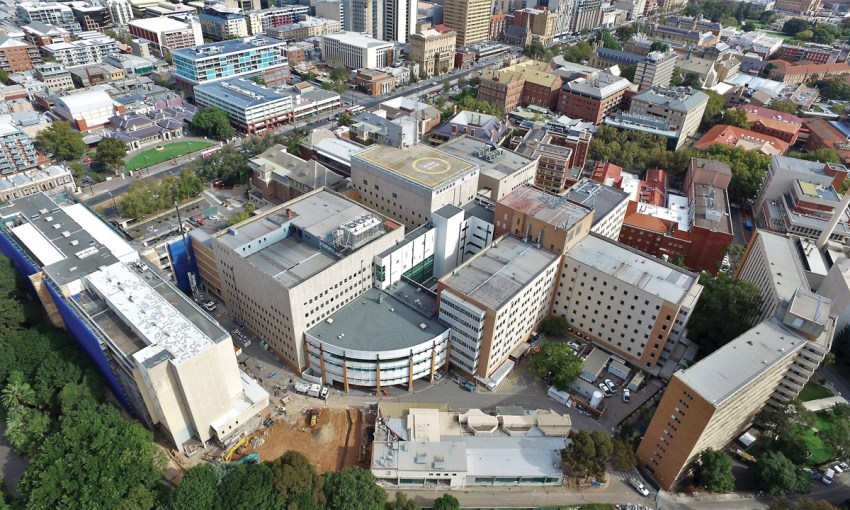The former Royal Adelaide Hospital site is being transformed into a hub for innovation, art and culture – a “future factory” for generations of South Australians to come.
Operation transformation
At 7am on September 5th last year, the site formerly known as the Royal Adelaide Hospital closed the sliding doors of its emergency department.
To connect with the Former Royal Adelaide Hospital site and upcoming activations, visit the website.
Two minutes later a man got out of a car, sat in a wheelchair and was admitted to the emergency department (ED) of the Royal Adelaide Hospital – this time at the corner of West and North Terrace. Three ambulances in 10 minutes followed the wheelchair-bound man into the ED and thus the transition of a city’s hospital from one site to another was official.
While the switch from one ED to another was instantaneous, the process of repurposing a historic hospital on a site with intrinsic cultural and economic value to the state is a complex process involving myriad stakeholders.

Demolition work in progress.

The protective wrap around the East Wing building features a design by Adelaide artist Vans the Omega.
Renewal SA is managing the renewal of the former RAH site on behalf of the State Government. General Manager People and Place, Georgina Vasilevski, says it’s one of the State’s most important projects.
The creation and innovation neighbourhood is bringing together start-ups, incubators, investors and mentors across 20,000 square meters within seven heritage and historic buildings, creating the high value jobs and industries that will thrive in a collaborative, entrepreneurial culture. These buildings are being reconfigured to foster the growth of early stage businesses through collaboration and interaction.
“The neighbourhood must be designed with flexibility to dynamically evolve over decades to meet needs that we have not imagined and host people who are not yet born,” Georgina says.
“Premier Marshall’s vision is about creating a place for emerging industries and imagining a future where our children kick start their own ventures while being educated in the technologies of the 21st century.”
The vision also includes a national Aboriginal art and culture gallery, an international centre for tourism, hospitality and food studies and short stay accommodation for visiting entrepreneurs, researchers and scientists.
The multi-dimensional project of repurposing the hospital site is advanced. Stage One of the demolition schedule is underway on the 1960s era East, Cobalt and Hone wings and Emergency Link building and tenders have been advertised for demolition of other obsolete buildings on the site under Stages Two and Three.
The Women’s Health Centre on the corner of Frome Street and North Terrace is being adapted for the new Australian Institute for Machine Learning, which will see 200 people moving into the premises in November. Other on site tenants include Sparkke Change Beverage Company and KiK Innovation.
The neighbourhood is also hosting regular activations to herald its transition from hospital to innovation hub. The Lot 14 Pop-Up venue over Fringe offered family-friendly activities, while a gold-painted shipping container was plonked down on site to connect Adelaide with far-away places such as Afghanistan and the Gaza Strip through an interactive video hook up.
The Foyer used to be the hospital’s main entrance, now it’s a venue for public events. In early May, a sold-out crowd of 300 listened to Canadian innovation expert Dr Ilse Treurnicht, describe how a former major hospital in Toronto has been transformed into the MaRS Discovery District.
Upcoming activities include Hello Fridays, an after work offering of food, drinks and live music, plus group fitness, meditation, massage, creative workshops and master classes, and food and drink pop-ups.
People interested in the stories of the old hospital have a short window of opportunity to join history tours. These access areas which were previously closed to all but authorised personnel and include some of the buildings to be demolished. All five tours held in May sold out, with more planned for June and July.
Those keen to learn about what is happening at the site now and in the future can join community open days, starting in July. These will be centered on the Observation Deck, a former staff canteen which now offers excellent views of the demolition work on the eastern side of the site.
More than 20,000 people have visited the site since September last year and Georgina said continued public engagement was just as important as demolition and construction.
“The former RAH is going to be radically transformed over the next eight years and it’s important that we partner with community and industry on this transformational journey, as well as demonstrating the site’s potential to entrepreneurs and innovators,” says Georgina.




